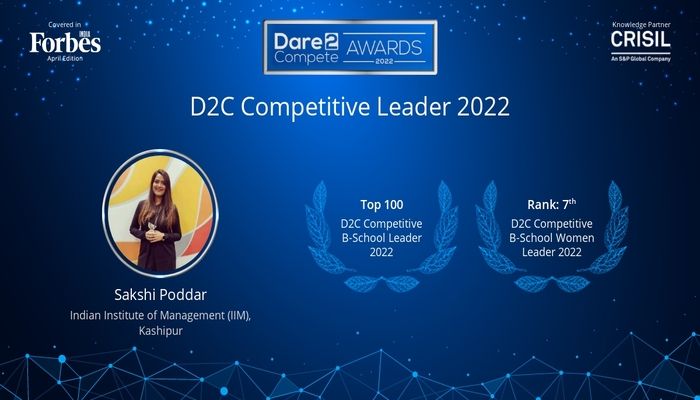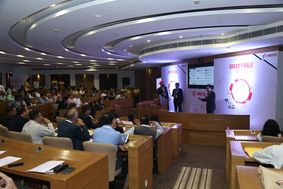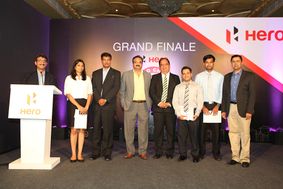"Fail Fast And Fail Forward" Says D2C Competitive Leader 2022 Sakshi Poddar From IIM Kashipur

“Success is no accident. It is hard work, perseverance, learning, studying, sacrifice, and most of all, love of what you are doing or learning to do.”
B-School competitions provide you with a platform to demonstrate talent, build an exceptional network system and are a stepping stone to achieving greater things in life. Though the means are unconventional, these competitions provide effective ways of securing internships, scholarships, jobs, and real-world experiences.
The Journey
Case competitions allow students to apply what they learn in the classrooms to real-world problems. The competitions provide an incredible opportunity to not just study but also to have that learning validated in real-time. Every day, I would spend a little portion of my time sifting through the competitions on the D2C platform, hoping to discover ones that piqued my interest. I participated in a number of them, focusing solely on improving slightly and learning a little more with each competition.
The plan was to 'fail fast and fail forward,' building a portfolio of failed efforts, each of which provided me with valuable information about the process. Then, as if by magic, the wins began to pile up. On 13 February 2021 I won my first ever B-School case study competition, and then I realized that to accomplish great things, we must n only act but also dream; not only plan but also believe. Then it was followed by Thoucentric Bottoms Up Season 2.0 where I surprised even myself, emerging the winner among 3000+ participants. Then, Krunchh - The Analytics Event organized by IIT Madras where we again emerged as the winners. There were numerous competitions like HP Solve, Resolvr - A competition by Smart Cubes, Phoenix Global National Case Competition to name a few followed in quick succession, where I was either a Runner-Up or among the finalists. The reward for the same was being recognized as a D2C Competitive leader.
1) Create a well-rounded team
A successful solution will emerge from a team with individuals who have varied areas of expertise and abilities, just as it does in any genuine business context.
Given the vast range of case topics, it's best to have a team with experience in a variety of sectors, such as marketing, analytics, operations, HR, and finance, to mention a few. It also helps if one of your team members is well-versed with Excel which allows the presentation to have an edge.
2) User Research
Every team will research the topic, but the ones who shine are the ones willing to put in a little extra effort towards finding relevant data from all sources. This will stand as a clear demonstration of your expertise and interest in the client’s organization.
3) Keep it laser-focused
When it comes to tackling an innovative problem, there are always a lot of intriguing options. We discovered that picking the most compelling solution is the most successful strategy. Then explain why you picked it and flesh it out in-depth for the audience. A single, profound, and well-studied answer will wow the audience far more than a series of wide and superficial ones.
4) Know your numbers
It is always pleasant to answer a judge's doubting query with, "Yes, and we have data to support it," during Q&A time. If you are planning to respond, be sure that you have done your homework first. While just relevant figures should be supplied, an appendix is a useful addition for all the numerical material you might wish to use during follow-up questions. In addition, make sure you practice speaking convincingly about how you arrived at your final figures.
5) Put it into action
Judges want ideas that seem real — ones that can be put into action quickly, within their existing budget and are pleased to share with internal stakeholders. Make a detailed plan for how you will launch your project, including how much financial input you will need and what current resources you may require. You can always lay out a plan for how your solution may improve and grow as you scale if you want to stand out from the competition (three, five, or ten years down the line).
6) Make up a storyline
Although business jargon and figures may appear impressive, if the judges are not captivated, they may overlook the ingenuity of your solution. Storytelling may help you stand out from the crowd and connect with your audience. To illustrate how this solution will impact the lives of consumers and stakeholders, share passionate and powerful tales from personas or individuals you interacted with.
7) Make it appealing
It is impossible to ignore the importance of a visually appealing presentation. Your audience will be aware and engaged as a result of this. Simple design features and straightforward, clear slides will go a long way.
8) Scripting for the final presentation
I have seen far too many excellent case presentations go bad because the speakers were not prepared with a script. If you are on a tight schedule and have a lot of stuff to cover, make sure you have a script on hand that you can read from to make your job simpler. Simply reading the material out loud on each slide does not offer value; the value comes in when you can draw the reader's attention to your crucial insight - the section you want them to read. Discuss why a slide is included and how it directly aids you in solving the case.
I am not an expert myself. I have shared these bits of advice so that my juniors and fellow leaders in the future can learn from the mistakes I made. Huge shoutout to Unstop (formerly Dare2Compete)for encouraging us with D2C awards which make us work with more passion towards winning and acing competitions.
P.S-Thanks to Hemanth for being my most supportive teammate who always pushed me to work out of my comfort zone
The story has been shared by Sakshi Poddar from IIM Kashipur after being awarded as one of the D2C Competitive Leaders 2022.
Login to continue reading
And access exclusive content, personalized recommendations, and career-boosting opportunities.
















Comments
Add comment